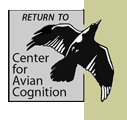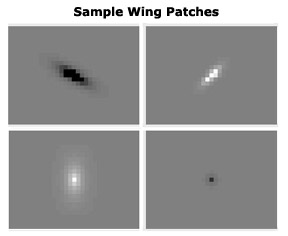


Virtual Genetics
The virtual moth genome (Bond & Kamil 2002) incorporated many features of the developmental genetics of the wing patterns of moths and butterflies (Robinson 1971; Nijhout 1991; Carroll et al. 1994; Brakefield et al. 1996), including loci that code for individual patches of pattern elements, loci that produce global changes in wing brightness or contrast without modifying pattern elements, and linkage mechanisms that protect favorable genetic combinations from being lost during recombination. As in real moths, phenotypic characters were polygenic. The intensity of each of the 75 unique pixels in the phenotype was affected by multiple overlapping patches that interacted additively, providing redundancy and maintaining genetic variance in spite of the absence of heterozygosity. Genome Structure
gene patch loci and a block of three regulator genes.The five genes in each patch locus, taken together, defined an elliptical pixel patch of specified location, size, shape, and brightness. Each regulatory locus included genes for global brightness, global contrast, and the probability of recombination between cistrons. Values of the brightness and contrast regulators were summed over the genome, and their aggregate value determined adjustments in absolute or relative brightness that were applied to the entire wing. Mutations in just a few of these regulatory locations could rapidly produce very bright or dark moths.
Recombination in this system helped to insure that deleterious patterns were rapidly removed from the population. To preserve integrated pattern features from being broken up by recombination, crossing-over only took place between linkage groups, and the probability of a cross-over was determined by the combined values of the recombination probability regulators above and below the exchange point. Similar recombination restraints are common in the developmental genetics of real lepidoptera (Nijhout 1991).
Selective AlgorithmOur moth population was maintained at a constant density of 200 individuals, but each day the gene pool was reassorted, producing a novel generation of prey. At the start of the session, phenotypes were developed from the current population of genotypes and exposed to jay predation. For each moth, the program recorded whether that individual was correctly detected and, if so, how long the bird took to find it. After all moths had been presented to jays, the fitness of each individual in the population was evaluated, based on its success at avoiding detection. A genetic algorithm provided the interface between the birds' detection performance and its selective effects on the moths. Moths that were overlooked had 2.5 times the probability of being chosen to breed as the average detected individual. Within the group of detected moths, individuals were ranked in inverse order of the time the bird took to detect them, and the highest-ranked individual had a 25% higher probability of being chosen than the lowest-ranked.
Pairs of moths were chosen at random from the pool, in accordance with their fitness values, and their two genomes were recombined to produce a single progeny chromosome. The parents were subsequently returned to the pool and could be chosen again in a subsequent random draw. Once each progeny genome was obtained, it was passed through a mutation step. Mutation was accomplished in bitwise fashion, considering the 117-byte genome as a string of 936 binary digits. The mutation algorithm searched down the string and, with a fixed probability of 0.003, randomly selected digits to be toggled. To regulate the magnitude of the effects of single mutations, we used Gray code, which minimizes the difference in number of bits between adjacent integers, for interpreting individual gene values (Bäck 1996; Mars, Chen & Namibar 1996).
Production of a new generation entailed iterated selection, recombination, and mutation steps until 200 progeny individuals had been obtained. For the following day's session, the parental population was discarded and replaced with the progeny. There was no generational overlap.
References from Other Sources
Bäck, T. (1996). Evolutionary Algorithms in Theory and Practice. New York: Oxford U. Press.
Brakefield, P.M., Gates, J., Keyes, D., et al. (1996). Development, plasticity and evolution of butterfly eyespot patterns. Nature 384: 236-242.
Carroll, S.B., Gates, J., Keyes, D.N., et al. (1994). Pattern formation and eyespot determination in butterfly wings. Science 265: 109-114.
Mars, P., Chen, J.R., & Nambiar, R. (1996). Learning Algorithms: Theory and Applications in Signal Processing, Control, and Communications. Boca Raton, FL: CRC Press.
Nijhout, H.F. (1991). The Development and Evolution of Butterfly Wing Patterns. Washington, D.C.: Smithsonian Institution.
Robinson, R. (1971). Lepidopteran Genetics. Oxford: Pergamon.





